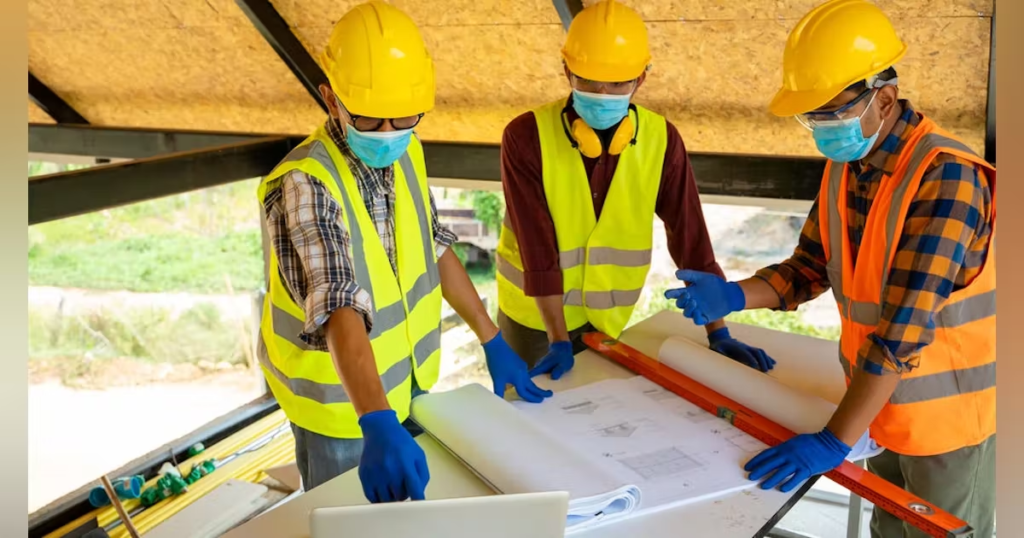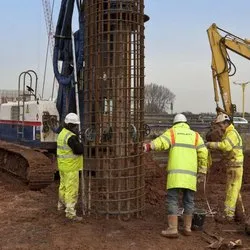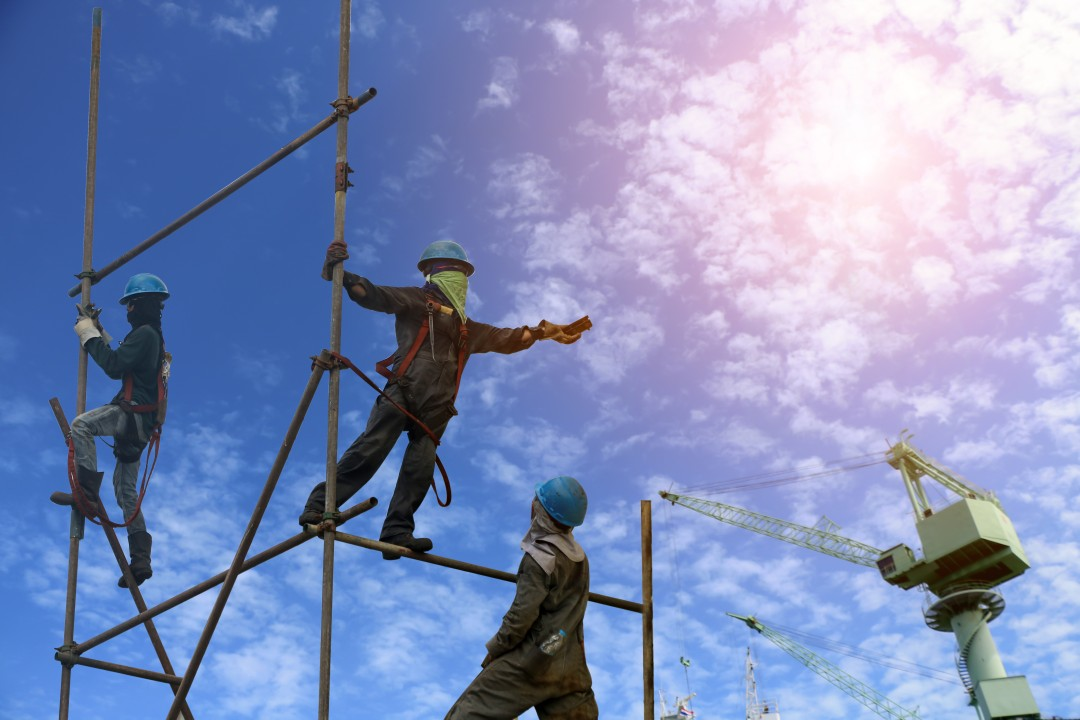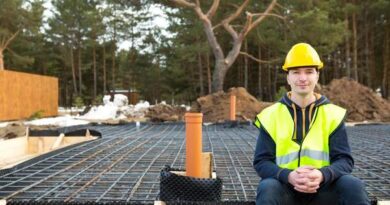Assistant Construction Fitter (6 month course)
Assistant Construction Fitter click here
Brief Job Description
Assistant Construction Fitter provides assistance in fit up activities by placing, positioning and fixing
different components after conducting proper measurements, markings and edge preparation under the
supervision of trade senior.

Personal Attributes
The individual should be physically fit and mentally alert and safety conscious to be able to work across
various locations in extreme weather/site conditions, preferably not suffering from any respiratory
disorder, vision defects and skin allergies due to exposure to light and heat. The person must be able to
perform efficiently within a team, handle the various fabrication tools and materials.
Identify and mark structural steel elements to assist in fit-up
of the same
Description
This unit describes the skills and knowledge required to identify and mark structural steel elements to
assist in fit-up of the same
Scope
The scope covers the following :
Identify the structural steel material for measurement and marking of fit-up
Elements and Performance Criteria
Identify the structural steel material for measurement and marking of fit-up
To be competent, the user/individual on the job must be able to:
PC1. identify and distinguish the materials based on their shape, size and thickness
PC2. select materials as per requirements and instructions
PC3. conduct liner measurements like length, width, diameter, using proper measuring tools like
tapers, rulers, calipers etc

PC4. read and understand hand sketches/ drawings to interpret fit up requirements
PC5. place the sections, plates, pipes or tubes in position as per instructions
PC6. mark on the surface of sections the position of bolts, plates or sections for fit-up as per
instructions
PC7. recheck the markings w.r.t hand sketches to confirm its correctness
PC8. report any undulations or bends encountered during measurements to superiors
Knowledge and Understanding (KU)
The individual on the job needs to know and understand:
KU1. request procedure for tools & materials
KU2. housekeeping & other administrative rules
KU3. information flow hierarchy and appropriate modes of communications as applicable on site
KU4. different types of sections, plates etc.
KU5. identification and use of different measuring instruments
KU6. read and understand hand sketches/ drawings
KU7. how to handle heavy materials
KU8. safety hazards while working with heavy materials
KU9. methods of measuring and marking
KU10. correct procedures of tools and equipment usage for the grinding operations
KU11. effect of different types and grades of grinding achievable by various tools to achieve
required surface finish
KU12. personal protective equipment (PPE) and clothing that must be worn during the grinding
activity and from where can it be obtained
Generic Skills (GS)
User/individual on the job needs to know how to:
GS1. write in one or more language, preferably in the local language of the site
GS2. read one or more language, preferably in the local language of the site
GS3. read instructions, guidelines, sign boards, safety rules & safety tags instruction related to
exit routes during emergency at the workplace
GS4. speak in one or more language, preferably in one of the local language of thesite
GS5. listen and follow instructions / communication shared by superiors/ coworkers regarding
team requirements or interfaces during work processes
GS6. orally communicate with co-workers regarding support required to complete the respective
works
GS7. decide upon the measuring instruments to be used for carrying out given set of
measurements
GS8. identify and use relevant tools effectively
GS9. complete work as per agreed time and quality
GS10. identify the marking to be checked in the hand sketch and refer the same while checking the
actual marking
GS11. observe the gap between tape , line dori etc. and the metal surface during measurement to
identify and locate any undulations
Identify, use various tools, tackles and handle heavy
materials used in fit-up of fabricated components
Description
This unit describes the skills and knowledge required to identify and use various tools, tackles and handle
heavy materials used in fit-up of fabricated components
Scope
The scope covers the following :
Work according to standard health and safety requirements
Identify and use of tools &tackles to be used in fit-up
Shift structural steel sections to instructed locations
Elements and Performance Criteria
Work according to standard health and safety requirements
To be competent, the user/individual on the job must be able to:
PC1. identify any potential hazard in the work area related to own work and report the same to
appropriate authority
PC2. avoid any unsafe act by self particularly while working at site
PC3. avoid wearing any loose clothing and preferably wear the yard jumpsuit or any other uniform
issued at site
PC4. select and correctly use personnel protective equipment as per work requirement
PC5. dispose of any unwanted material from the work area as per instructions
PC6. participate in safety drills organized at site
PC7. participate in perp talks and tool box talks organized at site
Identify and use of tools & tackles to be used in fit-up
To be competent, the user/individual on the job must be able to:
PC8. identify and use correct tools and tackles required for Marking like scribers, dividers,
punches etc
PC9. identify and use correct tool and tackle for liner and angular measurements like steel rule,
tapes, angle gauges etc.
PC10. identify and use correct tool and tackle for holding and tightening the metal pieces such as
wrenches, vices, different types of clamps etc.
PC11. identify and use correct tool for cutting and striking metal such as file, chisels, hammers etc
PC12. identify and use different types of lifting and shifting arrangements such as chain pulley
blocks, trolleys etc.
PC13. carry out basic upkeep of all hand tools and tackles
Shift structural selections to instructed locations
To be competent, the user/individual on the job must be able to:
PC14. identify the material to be shifted
PC15. check the access if any obstructions and report to concerned authority
PC16. perform visual checks for good working condition of hand tools like sling, rope, clamp hook
etc.
PC17. anchor the structural member in its right position during lifting to avoid accidents,
overturning of lifting machines
PC18. control position of suspended objects when being shifted by means of mobile hydraulic lifting
equipment’s
PC19. stack heavy objects appropriately as per standard practice

Knowledge and Understanding (KU)
The individual on the job needs to know and understand:
KU1. standard practices of construction fitting works
KU2. safety rules and regulation for handling and storing required construction fitting tools,
equipment and materials
KU3. personal protection including the use of related safety gears & equipment
KU4. how to request tools and materials as per set procedures
KU5. maintenance of tools and equipment
KU6. different hand and power tools available in market for fabrication activity
KU7. application of commonly used hand and power tools used in fabrication shop
KU8. selection and correct use of different tools and tackles as per the work requirement
KU9. how to use the tools in optimized manner
KU10. how to carry out basic maintenance of different hand and power tools
KU11. tolerance limits and range of operation for all common hand and power tools
KU12. ergonomic principles to carry loads
KU13. tools and tackles to be used in basic rigging work
KU14. standard practices regarding heavy material lifting and shifting
KU15. safety measures to be taken while object to be shifted is in mobility
KU16. correct posture of lifting equipment during lifting and shifting an object
KU17. load lifting capacity of lifting equipment
KU18. basic maintenance of load lifting equipment
KU19. different hazards associated with fabrication activities
KU20. types of fires and different fire safety equipment’s used
KU21. safety evacuation points
KU22. safety guidelines for working in a fabrication yard
KU23. how to identify and dispose waste and scrape materials from the workplace
Generic Skills (GS)
User/individual on the job needs to know how to:
GS1. write in at least one language, preferably in the local language of the site
GS2. read in at least one language, preferably in the local language of the site
GS3. read instructions, guidelines, sign boards, safety rules and safety tags
GS4. read instructions and exit routes during emergency
GS5. speak in one or more language, preferably in one of the local language of thesite
GS6. listen and follow instructions communicated by supervisors
GS7. communicate orally and effectively with team member
GS8. decide the tool or instrument to be used for a particular task
GS9. decide whether the selected tool requires repairs to perform intended task
GS10. plan self-work as per instructions given by superiors
GS11. ensure work is done within time and as per desired quality as per instructions provided by
superiors
GS12. check and confirm that the anchorage provided to the structural members is as per
instructions to avoid accident while lifting
Assist in preparatory activities, edge reparation and positioning of steel sections for fit-up
Description
This unit describes the skills and knowledge required to assist in preparatory activities, edge preparation
and positioning of steel sections
Scope
The scope covers the following :
Prepare fabrication platform before starting fit-up operations
Prepare the edges of the components of assemblies
Position and fix structural elements
Elements and Performance Criteria
Prepare fabrication platform before starting fit up operations
To be competent, the user/individual on the job must be able to:
PC1. clean the platform to remove any scrap metal
PC2. dispose the scrap at instructed location

PC3. remove any temporary anchors, supports etc. installed previously for other fit-up
PC4. check all the tools and tackles for holding, tightening, striking etc.
PC5. rearrange all jacks, clamps as per requirement
PC6. clean the surface of the structural sections or components before starting the welding works
PC7. clear the fabrication platform area so that there is no obstruction for shifting of components
PC8. PC8. carry out layout of components/ sections on prepared fabrication platform from hand
sketches
PC9. carry out layout of components/ sections on prepared fabrication platform
Prepare the edges of the components of assemblies
To be competent, the user/individual on the job must be able to:
PC10. mark the positions of the edges to be prepared as per hand sketches and instructions
PC11. read and understand hand sketches to interpret edge preparation requirements and confirm
the same from superiors if required
PC12. confirm the orientation of bevel and scallop from superiors
PC13. operate the beveling machine if required for scalloping and beveling as per instructions
PC14. follow all safety guidelines while operating beveling machine
PC15. confirm that profile of bevel and scallop is as per instructions or work requirements
PC16. identify any undulations or other faults in the section if any and report the same to superiors
PC17. carryout jacking or striking operations as per instructions for removal off minor defects under
close supervision
Position and fix structural elements
To be competent, the user/individual on the job must be able to:
PC18. place the structural component on the fabrication platform as per instructions
PC19. ensure that position and orientation of the component is as per instruction
PC20. check if the markings on the section are clearly visible prior to fixing the section
PC21. check that material has been scalloped as per instructions or hand sketches
PC22. check that edge preparation has been done as per instructions or hand sketches
PC23. place and tighten the clamps at required positions to restrict the movement of section
PC24. place other components post dimensional checking upon the fixed section as per
requirements and tighten the required clamps
PC25. adjust the fit-up precisely using striking, jacking or other methods as per instruction
PC26. mark the locations for tack welds as per instructions
PC27. recheck the dimensions of the assembly post tack welding
PC28. loosen the clamps or vices etc. to facilitate the removal of fitted section/ assembly
PC29. attach proper ropes, belts etc. for lifting and shifting of material as per requirement
Knowledge and Understanding (KU)
The individual on the job needs to know and understand:
KU1. standard practices of construction fitting works
KU2. safety rules and regulation for handling construction fitting tools
KU3. personal protection including the use of related safety gears & equipment’s
KU4. how to request tools and materials as per set procedures
KU5. maintenance of tools and equipment’s
KU6. how to identify the scrap metal lying on the fabrication platform according to section and
dimensions

KU7. how and where to dispose of the scrap
KU8. importance of housekeeping in relevance with fabrication activities
KU9. introduction to fabrication terminologies like jacking, heating, job, etc
KU10. how to install temporary supports and clamps for restricting the movements of work pieces
and holding the in position
KU11. importance of clamps and its functions in fit-up work
KU12. steps involved in removing the work pieces from the platform postfix-up
KU13. basic concept of working principle of jacks (hydraulic and pneumatic) and respective uses
KU14. technique of checking the workability of tools and tackles according to acceptance criteria
KU15. how to identify obstructions for lifting
KU16. how to read and interpret hand sketches and simplified fabrication drawings
KU17. importance of proper orientation of work piece
KU18. how to identify and know the steps to be taken to finish the surface before fitting
KU19. the steps of checking the dimensions of the work pieces during fit-up
KU20. importance of accurate fit-up
KU21. know hows of accurate fit-up
KU22. what is meant by welding shrinkage, its causes, and effects
KU23. distortion control techniques and their areas of applications
Generic Skills (GS)
User/individual on the job needs to know how to:
GS1. write in at least one language, preferably in the local language of the site
GS2. read in at least one language, preferably in the local language of the site
GS3. read instructions, guidelines, sign boards, safety rules and safety tags
GS4. read instructions and exit routes during emergency
GS5. speak in one or more language, preferably in one of the local language of the site
GS6. listen and follow instructions communicated by supervisors
GS7. communicate orally and effectively with team member
GS8. decide whether the surface of structural sections and components are suitably cleaned prior
to initiating welding works
GS9. plan self-work as per instructions given by superiors
GS10. ensure work is done within time and as per desired quality as per instructions provided by
superiors
GS11. check for undulations / faults in the section and report the same to superiors
GS12. remove minor defects by carrying out jacking or striking operations under supervision
GS13. confirm the orientation of job before carrying out edge preparation
GS14. analyze the actions of self that may result in unsafe conditions
GS15. review the markings for edge preparation to confirm their compliance with given instructions
Work effectively in a team to deliver desired results at the workplace
Description
This unit describes the skills and knowledge required to work effectively within a team to achieve the
desired results
Scope
The scope covers the following :
Interact and communicate effectively with co-workers, superiors and sub-ordinates across different
teams
Support co-workers, superiors and sub-ordinates within the team and across interfacing teams to
ensure effective execution of assigned task
Elements and Performance Criteria
Interact and communicate in effective and conclusive manner
To be competent, the user/individual on the job must be able to:
PC1. pass on work related information/ requirement clearly to the team members
PC2. inform co-workers and superiors about any kind of deviations from work
PC3. address the problems effectively and report if required to immediate supervisor appropriately
PC4. receive instructions clearly from superiors and respond effectively on the same
PC5. communicate to team members/subordinates for appropriate work technique and method
PC6. seek clarification and advice as per the requirement and applicability
Support co-workers to execute project requirements
To be competent, the user/individual on the job must be able to:
PC7. hand over the required material, tools tackles, equipment and work fronts timely to interfacing
teams
PC8. work together with co-workers in a synchronized manner

Knowledge and Understanding (KU)
The individual on the job needs to know and understand:
KU1. own roles and responsibilities
KU2. importance of effective communication and establishing strong working
KU3. risks of a failure in teamwork in terms of effects on project outcomes, timelines, safety at the
construction site, etc.
KU4. different modes of communication, and its appropriate usage
KU5. importance of creating healthy and cooperative work environment among the gangs of
workers
KU6. different activities within his work area where an interaction with other workers is required
KU7. applicable techniques of work, properties of materials used, tools and tackles used, safety
standards that co- workers might need as per the requirement
KU8. importance of proper and effective communication and the expected adverse
KU9. importance and need of supporting co-workers facing problems for smooth
Generic Skills (GS)
User/individual on the job needs to know how to:
GS1. write in at least one language, preferably in the local language of the site
GS2. read in one or more languages, preferably the local language of the site
GS3. read communication from team members regarding work completed, materials used, tools
and tackles used, support required
GS4. speak in one or more languages, preferably in one of the local language of the site
GS5. listen and follow instructions / communication shared by superiors/ co-workers regarding
team requirements or interfaces during work processes
GS6. orally communicate with co-workers regarding support required to complete the respective
work
GS7. decide on what information is to be shared with co-workers within the team or from
interfacing gang of workers
GS8. plan work and organize required resources in coordination with team members
GS9. complete all assigned task in coordination with team members
GS10. take initiative in resolving issues among co-workers or report the same to superiors
GS11. ensure best ways of coordination among team members
GS12. communicate with co-workers considering their educational / social background
GS13. evaluate the complexity of task and determine if any guidance is required from superiors
Work according to personal health, safety and environment protocol at construction site
Description
This NOS covers the skill and knowledge required for an individual to work according to personal health,
safety and environmental protocol at construction site
Scope
The scope covers the following :
Follow safety norms as defined by organization
Adopt healthy & safe work practices
Implement good housekeeping and environment protection process and activities
Elements and Performance Criteria
Follow safety norms as defined by organization
To be competent, the user/individual on the job must be able to:
PC1. identify and report any hazards, risks or breaches in site safety to the appropriate authority
PC2. follow emergency and evacuation procedures in case of accidents, fires, natural calamities
PC3. follow recommended safe practices in handling construction materials, including chemical
and hazardous material whenever applicable
PC4. participate in safety awareness programs like Tool Box Talks, safety demonstrations, mock
drills, conducted at site
PC5. select and operate different types of fire extinguishers corresponding to types of fires as per
EHS guideline
PC6. identify near miss , unsafe condition and unsafe act
Adopt healthy & safe work practices
To be competent, the user/individual on the job must be able to:
PC7. use appropriate Personal Protective Equipment (PPE) as per work requirements including:
Head Protection (Helmets), Ear protection Fall Protection, Foot Protection, Face and Eye
Protection, Hand and Body Protection, Respiratory Protection (if required)
PC8. handle all required tools, tackles , materials & equipment safely
PC9. follow safe disposal of waste, harmful and hazardous materials as per EHS guidelines
PC10. install and apply properly all safety equipment as instructed
PC11. follow safety protocol and practices as laid down by site EHS department
PC12. undertake and pass height pass test as per EHS guideline
Implement good housekeeping practices
To be competent, the user/individual on the job must be able to:
PC13. collect and deposit construction waste into identified containers before disposal, separate
containers that may be needed for disposal of toxic or hazardous wastes
PC14. apply ergonomic principles wherever required
Knowledge and Understanding (KU)
The individual on the job needs to know and understand:
KU1. reporting procedures in cases of breaches or hazards for site safety, accidents, and
emergency situations as per guidelines
KU2. types of safety hazards at construction sites
KU3. basic ergonomic principles as per applicability
KU4. the procedure for responding to accidents and other emergencies at site
KU5. use of appropriate personal protective equipment to be used based on various working
conditions
KU6. importance of handling tools, equipment and materials as per applicable
KU7. health and environments effect of construction materials as per applicability
KU8. various environmental protection methods as per applicability
KU9. storage of waste including the following at appropriate location: non-combustible scrap
material and debris, combustible scrap material and debris, general construction waste and
trash (non-toxic, non-hazardous), any other hazardous wastes and any other flammable
wastes
KU10. how to use hazardous material, in a safe and appropriate manner as per applicability
KU11. types of fire
KU12. procedure of operating different types of fire extinguishers
KU13. safety relevant to tools, tackles, & requirement as per applicability
KU14. housekeeping activities relevant to task
Generic Skills (GS)
User/individual on the job needs to know how to:
GS1. write in at least one language, preferably in the local language of the site
GS2. fill safety formats for near miss, unsafe conditions and safety suggestions
GS3. read in one or more language, preferably in the local language of the site
GS4. read sign boards, notice boards relevant to safety
GS5. speak in one or more language, preferably in one of the local language of the site
GS6. listen instructions / communication shared by site EHS and superiors regarding site safety,
and conducting tool box talk
GS7. communicate reporting of site conditions, hazards, accidents, etc.
GS8. not create unsafe conditions for others
GS9. keep the workplace clean and tidy
GS10. identify safety risks that affect the health, safety and environment for self and others
working in the vicinity, tackle it if within limit or report to appropriate authority
GS11. assess and analyze areas which may affect health, safety and environment protocol on the
site
GS12. ensure personal safety behavior








